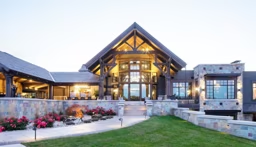
When you own a log or timber home (or dream of owning one), it’s often because of the one-of-a-kind wood features. Their rustic charm is unique, but just like any home, they require maintenance. That being said, a simple routine can keep your home in tip-top shape through the years. Here are a few easy strategies to get you started.
Include roof overhangs.
During the planning process, be sure to account for roof overhangs that are at least 3 feet deep. These will protect your exterior walls from moisture and sun exposure.
Consider the humidity levels.
While the exterior needs to remain as dry as possible, the interior wood of your home should maintain the right level of humidity for your region. A humidifier in the HVAC system can keep things in prime condition and add health benefits for your family.
Use proper stains and sealants.
These products will help your home look its best with minimal effort on your part. Once applied, they should last years before needing a touch-up. You’ll know it’s time to reapply when the wood starts to fade from the elements and time.
Perform a water test.
When checking the stain on your home, spray the exterior wood with water in several places. If the water beads up, your products are working. If wet patches appear, water is being absorbed, and a new coat of protection should be applied.
Keep your gutters clean.
Prevent gutter debris and buildup by installing mesh coverings over them and the downspouts. Rainwater will still filter through, but you’ll avoid the clogs that can result in overflow and saturated exterior walls.
Don’t forget landscaping.
Your landscaping can have a large impact on the health of your wood home. Keep groundcover and mulch at least 3 feet away from the bottom of your lowest wood pieces to prevent mold, pests and water damage.
Conduct checkups.
A seasonal or bi-annual checkup gives you a chance to find and monitor problem spots. Here are a few things to keep an eye out for as you perform your checkup:- Upward-facing checks (separation in the wood fibers)
- Breaches in the chinking or sealant
- Soft wood and/or rotting areas
- Window frames/sills and other spots that may get overlooked in routine maintenance
- Mold or mildew buildup, often showing up in the form of a black or grayish-green film











